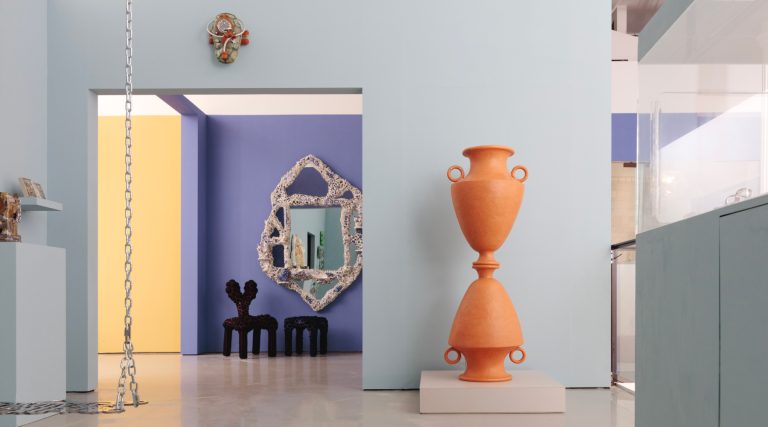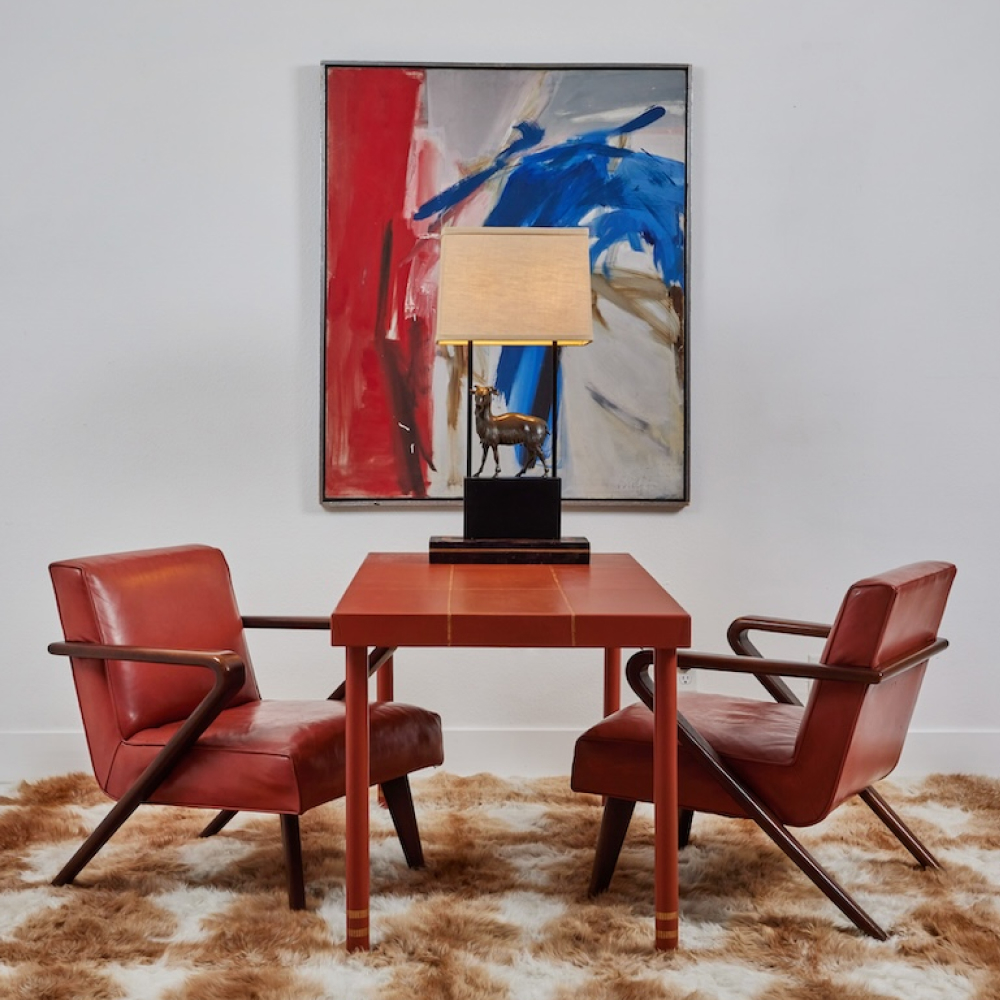
July 9, 2014Joel Shapiro’s silkscreen Toss Up, 2012. Top: Recently installed in the new U.S. Embassy in Kingston, Jamaica, Dorothea Rockburne’s Folded Sky, Homage to Colin Powell (Conceptual Rendering), 2009, depicts the starry sky the night Powell, the son of Jamaican immigrants, was born (photo by Paul Warchol).
Those who think the U.S. State Department’s art collection limits itself to presidential portraits, war memorials and rugged American landscapes are in for a surprise. Over the past two decades, and under the direction of collector and philanthropist Jo Carole Lauder, the nonprofit Foundation for Art and Preservation in Embassies (FAPE), has been steadily building a stellar permanent collection of contemporary art for the country’s embassies and consulates around the world. With the early help of former MoMA curator Riva Castleman, and more recently from Yale School of Art dean Robert Storr, FAPE has orchestrated major site-specific commissions by such artists as Lynda Benglis, Ellsworth Kelly, Maya Lin and Dorothea Rockburne, with dozens of others, from Robert Rauschenberg and Ed Ruscha to Tina Barney, contributing to the print and photography collections. “We should be showing the best of our country’s art to the rest of the world,” says Lauder, “and that’s exactly what FAPE is doing.”
Until now, seeing works from the State Department collection required entrée into the embassies or consulates that house them. But now, for the first time ever, a comprehensive selection of FAPE’s prints, photographs and maquettes of far-flung site-specific installations have been brought together for public viewing, at the Museum at Guild Hall, in East Hampton, New York, through July 27. Curated by Storr, who serves as chairman of FAPE’s Professional Fine Arts Committee, the exhibition shows the broad spectrum of work that FAPE has commissioned, from abstract sculptures to photos and prints that conjure more recognizable American symbolism: Carrie Mae Weems’ 2014 photo of the Lincoln Memorial, for instance, or James Rosenquist’s 2000 swirl of fragmented American flags.

James Rosenquist’s The Stars and Stripes at the Speed of Light, 2000
“It’s a way that the variety and texture of our country is made known,” says Storr, who works with Lauder, FAPE president Eden Rafshoon, vice president Darren Walker (also president of the Ford Foundation), board members and a committee of top art advisers and curators to determine which artists to approach. The hope is that people abroad will see “something different than the image of America implanted by the media, something that will change their sense of the monolithic nature of this country,” says Storr. “It’s an art of patriotism without there being a political attachment.”
Patriotism is not often associated with contemporary art, but given that these artists are working voluntarily and donating their pieces to the State Department, there clearly is a sense of devotion to the notion of art-as-diplomacy. “Having art in embassies, something diplomats can refer to, is very important. There’s a power in silent diplomacy,” says sculptor Joel Shapiro, the first artist FAPE tapped, in 1998, to create a site-specific work, which stands at the U.S. embassy in Ottawa, Canada. Since then, Shapiro has also created for FAPE an abstract print — a carefully balanced jumble of red and blue geometric forms — and installed a large vibrant blue sculpture at the American consulate in Guangzhou, China. “FAPE really allows artists to function with a high degree of freedom,” Shapiro says. “In that sense, the program reflects one of the best aspects about the country — that it’s open to the idea of defending individual freedoms.”

John Baldessari’s Three Government Personnel Considering and/or Deciding, 2008
Originally founded in the early 1980s by Leonore Annenberg, chief of protocol for President Ronald Reagan and wife of Walter Annenberg, former U.S. Ambassador to the United Kingdom, FAPE is not a government agency and is all privately funded. (Over the years, FAPE has raised tens of millions of dollars for the cause.) With a team of other diplomats, Annenberg first set off to help raise funds for embassy restoration and redecoration projects, including hanging American art. Lauder joined in 1988, upon her return from Austria, where her husband, Ronald Lauder — the force behind Manhattan’s Neue Galerie — had served as ambassador for a year. She helped steer the organization toward building a permanent collection, while still pursuing its preservation work. “It’s extremely expensive to crate and send things around the world and it seemed like a sensible thing to have pieces that would stay in place and become familiar to the people working in these places,” she says.
In 1989 FAPE began commissioning original artwork, establishing the Lee Kimche McGrath Original Print Collection, named for FAPE’s founding director. Since its inception, an American artist has donated an edition of original prints each year. Embassies receive them upon request. (Working pro bono, the prestigious printer Gemini has published dozens of prints for the program.) Last year, FAPE launched an original photography program as well, with William Wegman and Carrie Mae Weems among the debut artists.

Echoes for Marian, 2014, by Carrie Mae Weems, shows the artist in front of the Lincoln Memorial.
The site-specific installation program, however, begun in 1999, is what really secured FAPE’s role as a player on the cultural-diplomacy stage. In 1998, after the embassy bombings in Dar Es Salaam, Tanzania, and Nairobi, Kenya, the State Department launched a massive program to build new embassies around the world, and it called on FAPE to coordinate permanent, site-specific sculptures for each one (as well as for the new U.S. Mission to the United Nations building in New York City, which opened in 2010). The idea is to make the buildings more secure, but also to create architecturally inspiring settings that will enhance local communities and reflect positively on American culture.
“It’s been great because we can get in on the ground level, so we can see what might be possible,” says FAPE’s director, Jennifer Duncan. “Some of these pieces are quite monumental, so it helps that everything can be coordinated in the construction process.”
In some cases, as with Shapiro’s works and Martin Puryear’s massive stainless-steel arc slated to debut at the Beijing embassy in 2016, the sculptures grace public outdoor spaces, where they are visible to passersby and neighboring buildings — and distract from the fortress-like structures that arose to accommodate new security concerns. Others, like Benglis’s 2010 bronze wall-hung abstractions at the U.S. Consulate in Mumbai, welcome visitors inside. Whether figurative or abstract, the works serve to connect foreign visitors and local workers to the State Department buildings they occupy. “It humanizes the spaces,” says Lauder, of the art she has worked to have installed. “And it humanizes the government.”








